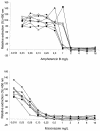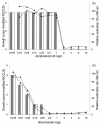In vitro susceptibilities of Madurella mycetomatis to itraconazole and amphotericin B assessed by a modified NCCLS method and a viability-based 2,3-Bis(2-methoxy-4-nitro-5- sulfophenyl)-5-[(phenylamino)carbonyl]-2H-tetrazolium hydroxide (XTT) assay
- PMID: 15215141
- PMCID: PMC434196
- DOI: 10.1128/AAC.48.7.2742-2746.2004
In vitro susceptibilities of Madurella mycetomatis to itraconazole and amphotericin B assessed by a modified NCCLS method and a viability-based 2,3-Bis(2-methoxy-4-nitro-5- sulfophenyl)-5-[(phenylamino)carbonyl]-2H-tetrazolium hydroxide (XTT) assay
Abstract
Susceptibilities of Madurella mycetomatis against amphotericin B and itraconazole in vitro were determined by protocols based on NCCLS guidelines (visual reading) and a 2,3-bis (2-methoxy-4-nitro-5-sulfophenyl)-5-[(phenylamino) carbonyl]-2H-tetrazolium hydroxide (XTT) assay for fungal viability. The XTT assay was reproducible and sensitive for both antifungals. Itraconazole (MIC at which 50% of the isolates tested are inhibited [MIC(50)]) of 0.06 to 0.13 mg/liter) was superior to amphotericin B (MIC(50) of 0.5 to 1.0 mg/liter).
Figures


References
-
- Ahmed, A. O., M. M. Mukhtar, M. Kools-Sijmons, A. H. Fahal, S. de Hoog, B. Gerrits Van den Ende, E. E. Zijlstra, H. Verbrugh, E. S. Abugroun, A. M. Elhassan, and A. van Belkum. 1999. Development of a species-specific PCR-restriction fragment length polymorphism analysis procedure for identification of Madurella mycetomatis. J. Clin. Microbiol. 37:3175-3178. - PMC - PubMed
-
- Andreu, J. M. 1986. Actual treatment of fungus mycetoma: interest in associating ketoconazole and conservative surgery. Med. Trop. (Mars) 46:293-297. - PubMed
-
- Bayles, M. A. 1992. Tropical mycoses. Chemotherapy 38:27-34. - PubMed
MeSH terms
Substances
LinkOut - more resources
Full Text Sources
Miscellaneous

